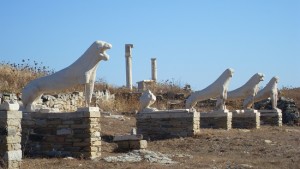Ancient Delos, southwest of Mykonos, is a tiny island (about 4 sq km) but it contains extensive Greco-Roman ruins which rival the ruins of Delphi and Olumpia, but be warned, if you are prone to seasickness, the island is located in one of the most turbulent areas of the Aegean. The boat trip takes about 40 minutes; in windy conditions (the norm), breakfast should be a dry bread roll or two, nothing more. In summer, there are also daily trips to Delos from Tinos.
Delos became a shrine because Leto. a nymph pregnant by Zeus, gave birth there first to Artemis and then, clutching a palm tree, to Apollo. A floating rock, Delos was rewarded for braving Hera’s jealous wrath by four diamond pillars that anchored it to the seabed.
Most of the ruins on Delos occupy a broad area on the island’s west coast. To the south is the theatre quarter (pictured), with various domestic buildings. On the north of the site are the sanctuaries to which pilgrims from all over the Mediterranean came with votive offerings and sacrificial animals.
For nearly one thousand years, Delos was the political and religious centre of the Aegean, and host to the Delian Festival, held every four years and, until the 4th century BC, Greece’s greatest religious gathering. The Romans turned it into a grand trade fair, and made Delos a free port. It also became Greece’s main slave market, where as many as 10,000 slaves (as against 25,000 local residents) were said to be sold daily. In 88 BC, Mithridates, king of Pontus, sacked Delos, followed by the pirate Athenodoros in 69 BC. It never recovered, and fell into disuse.
The Sanctuaries of Apollo and Dionysos
When you walk the island you should travel the pilgrim route from the Sacred Harbour to a ruined monumental gateway leading into the Sanctuary of Apollo. Within are three temples dedicated to Apollo and one to Artemis, and the remains of a colossal marble statue of the god. Close by is the Sanctuary of Dionysos, with several Dionysic friezes and outsized phalli standing on pedestals – including a marble phallic bird, symbolising the body’s immortality. Continue on to the stunning Lion Terrace, where five Archaic lions squat. (These are copies: the weathered originals, carved from Naxian marble are in the museum). Below this is the Sacred Lake, and a palm tree which marks the spot of Apollo’s birth.

You will doubtless delight in the residential portion of Delos, occupied by merchants rather than gods. Their houses, close to the commercial port, form a warren separated by narrow lanes equipped with Roman drains and niches for oil-burning street-lamps. The main street leads to the modest theatre, which seated 5,500, with superb views from the uppermost of its 43 rows. Either side of the theatre are grander mansions named for the subjects of their still-exquisite courtyard mosaics: Dionysos, Trident, Dolphin and Masks.
From the theatre quarter, a gentle stroll leads to the summit of Mount Kynthos (110m/36ft), offering memorable views of the ruins and the Cyclades. Finish off your visit by descending first past the Hellenistic grotto of Hercules, and then stopping at the terrace of shrines to the Foreign Gods. During the town’s prime, practically the entire Levant traded here, under the tutelage of shrines erected to their own divinities.
This really is an Island to see, so take some sea-sickness medication and make the trip – you will remember your visit for ever.
(Adapted from Greece Insight Guides – www.insightguides.com)










